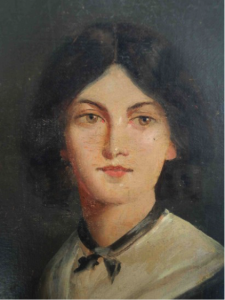 Love is like the wild rose-briar,
Love is like the wild rose-briar,
Friendship like the holly-tree —
The holly is dark when the rose-briar blooms
But which will bloom most constantly?
The wild-rose briar is sweet in the spring,
Its summer blossoms scent the air;
Yet wait till winter comes again
And who will call the wild-briar fair?
Then scorn the silly rose-wreath now
And deck thee with the holly’s sheen,
That when December blights thy brow
He may still leave thy garland green.
Brontë’s attitude toward love in this poem is telling, given how much she distanced herself from others in her own life. While Emily was very close with her sisters, Anne and Charlotte, she did not venture far outside of her family circle. Emily preferred the company of animals to people. She had a mastiff named Keeper, whom she adored. She never married, dying a single woman at the age of 30, an age that, at the time, was enough to deem her an “old maid.”
Besides her poetry, Emily Brontë wrote one novel in her lifetime, the famous Wuthering Heights. The novel, ironically, also focuses on love, detailing Heathcliff’s infatuation with Catherine and the impact her loss had on him. For someone who avoided love in her own life, Emily certainly enjoyed exploring the topic in her work.
Emily starts “Love and Friendship” by comparing love to a “wild rose-briar,” a comparison used many times thereafter (e.g., “Every rose has its thorn”). While love is beautiful, it can also bring pain. She then compares friendship to a holly tree, which is “dark when the rose-briar blooms.” During times of romance, she is saying, friendships fall to the wayside, and love takes over all feelings and emotions – “its summer blossoms scent the air.”
However, she says, during hard times – “winter” – the rose-briar does not hold up; it dies, leaving none of the beautiful flowers behind. Holly, however, lives on even in the coldest of months. Holly is the plant that will “bloom most constantly.” Friendship, then, lives on even when romances fade away.
The idea of love’s cruel sting in this poem is illustrated in Emily Brontë’s Wuthering Heights. Heathcliff’s anger and sorrow come from his inability to have Catherine, his true love, for his own. Love scorns him, hurting him like a rose thorn. As beautiful as he thinks Catherine is, the pain she brings to him leads to his downfall.
While Emily avoided love, her compassion for and closeness with her sisters must have motivated her portrayal of friendship in this poem. The three girls grew up together, using each other for support after their mother and sisters’ deaths – “when December blights thy brow” – and bonded through their writing.

